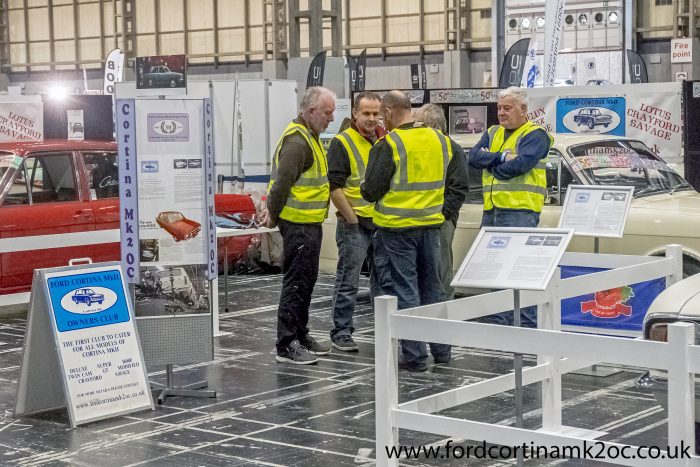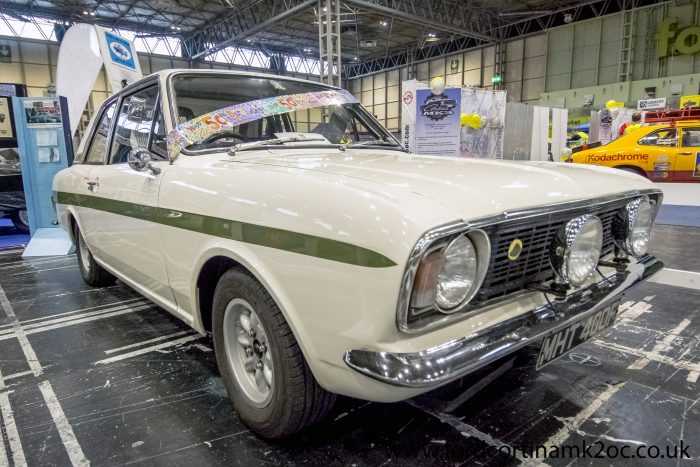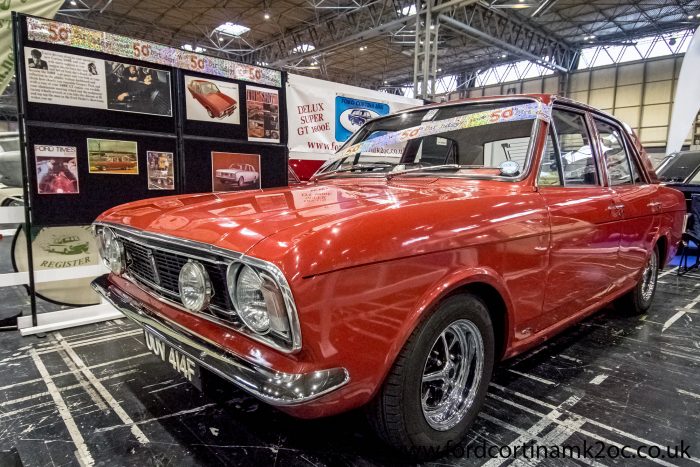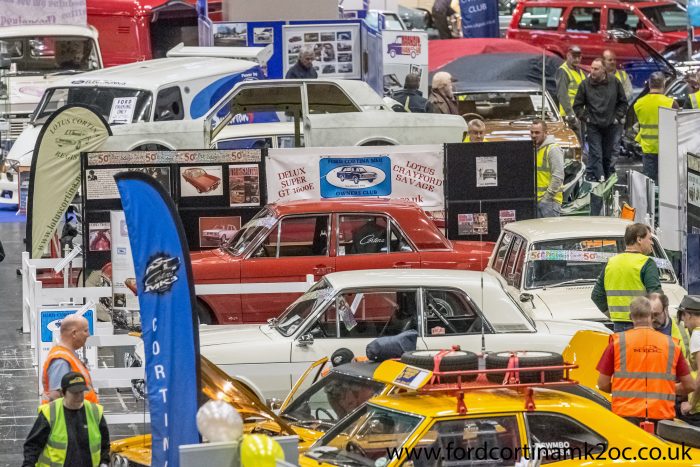What a great time we had at the 2017 Classic Motor Show where we’ve wrapped up our 50th anniversary celebrations of the MkII Cortina. Our thanks to Rob Archer, John Kirby and Phil Dunk for bringing along thier Cortinas, to our Somerset branch for building the excellent engine display, and of course to everyone who came along to say hello – you all made it a fantastic weekend once again. We’re already looking forward to next year when we’ll be celebrating another big anniversary, 30 years of the Ford Cortina MkII Owners Club. See you there!


Estate
Launched 15th February 1967
Price new – 1300 Deluxe £816, 1500 Super £889
Power – 1300 53.5 BHP, 1500 61 BHP
Total production – 90,290
Following the launch of the new MkII Cortina in October 1966 it was another 4 months, in February 1967, when Ford showed the estate version to the world. Initially available in Deluxe and Super trim with 1300 and 1500 pre-crossflow engines a GT version would be added to the range after the more powerful 1300 and 1600 crossflow engines arrived in the autumn of 1967 – by which time it had become Great Britain’s best selling estate car with nearly 25% of the market.
With the rear seats up there is 36 cubic feet of luggage space, but fold the rear seats flat and the load space is boosted to 70 1/5 cubic feet, more spacious that any other British production estate car of the time.
Just like the saloon versions, 4 speed manual gearboxes were standard with the 3 speed Borg Warner Type 35 auto gearboxes a factory fitted option for the 1500cc and crossflow engined cars. Manual column gear change could also be specified.
CTU 475F
First Registered 7th March 1968
Owned by Phil Dunk and friends since June 2005
This 1600 Super Estate was built at Dagenham in February 1968. The original green log book shows that CTU 475F was registered almost straight away as a dealer demonstrator by Manchester Garages (Wilmslow) on 7th March. It didn’t take long to find its first owner, it being registered to Mr L G Lathja (also of Wilmslow) less than 3 weeks later on 26th March 1968.
Phil spotted an advert in our (Ford Cortina MkII Owners Club) magazine “The Indicator” early in 2005, where then owner Brian Newbould described the estate as having been “off the road for many years but is suitable for restoration, free to a real enthusiast” – and he was right too, for Brian had taken the estate off the road some 23 years earlier in 1982. He made various repairs and got it painted but work stopped before putting it all back together again, which is where real enthusiast Phil stepped in. In fact, so much of an enthusiast that Phil was our club treasurer for over 13 years.
With the help of his son, Phil made a few more body repairs, fitted new brakes, and gradually put the estate back together before it passed an MOT test on 24/9/11, it’s first in nearly 30 years!
September 2016 saw Phil taking the estate apart again for some further restoration work which was to be complicated by earlier repairs. Having found white Hammerite happened to be a good colour match Phil had used it on some of those repairs without realising it would not be compatible with other paint finishes. The bodyshop started rubbing the estate down and quickly decided with the Hammerite and other unknowns hiding under the other paint, a full bare metal re-spray would be the only way to go. The cost rose considerably although the original price had not included the engine bay, interior, fitting a new headlining or removing and refitting the windows. It was ready for collection in June and the reassembly work begun straight away.
Parts used in the restoration include: all new door and glass rubber seals, new halogen headlights, new headlight bowls, new wing mirrors, new bulkhead weather seal, new headlining, full new old stock exhaust system, chrome exhaust trim, new twin horns, new 1600 super badge to tailgate, new Ford oval badge to lower front nearside wing, new silver on black number plates, new battery, new heater matrix and various other minor parts.

Cortina Lotus Twincam
Launched – March 1967
Price new – £1068
Power – 109 BHP
Total production – 4,032
It was around a month after the launch of the Estate, in March 1967, when the new Lotus Twincam version of the MkII Cortina was announced. Lotus were in the process of moving to Hethel in Norfolk when MkI Cortina production ended so Ford jumped at the opportunity to bring all Cortina manufacture “in house” for the MkIIs. Keen to let everyone know they had taken full ownership of the model Ford initially called it “Cortina Lotus” and later “Cortina Twincam”. The early press cars, along with the first race cars, even carried CTC **E number plates, CTC standing for Cortina Twincam. Most of these were white with the dealer applied optional green stripe but a couple of them also showed that the Cortina Lotus Twincam was available in any of the other MkII colours.
In racing terms, the Cortina Twincam was only ever going to be a stop gap – the race team was already developing the still to be announced MkI Escort – so a large amount of work was carried out to make it a much better road car than the original Lotus Cortina had been. They were very successful with their efforts too. Autocar stated: “….so much more refined than the earlier [MkI] car that there is scarcely any comparison between them. It is immensely better, and is now a thoroughly satisfying high-performance car…” Motor on the other hand said: “Anyone in the market for a £1100 saloon who doesn’t buy a Lotus Cortina must be mad.” Despite Ford’s best efforts, the Cortina Twincam was always still going to be known as a Lotus Cortina.
MHT 400F
First registered 16th August 1967
Owned by John Kirby since 2003
This Cortina Lotus Twincam was built in March 1967 making it one of the very earliest examples. It was restored in the early 1990s, various new panels were fitted before it benefitted from a full bare metal re-spray. With a future racing career in mind it was modified to suit with the addition of items such as a roll cage and high back recaro seats. A battery cut off switch was added while an alternator replaced the original dynamo to help the upgraded wiring system cope with the various extra equipment and lights such as rally spot lights, large reversing light, extra interior lighting and boot lights. The original 5 ½ inch steel wheels were fitted with studded winter tyres with genuine magnesium Minilite wheels available for all other duties, and the Lotus Twincam engine was rebuilt with a fresh block.
Once its restoration was completed it took part in a number of Norwich Union events and was also entered into the 1998 Monte Carlo Challenge. To ensure it complied with the regulations it needed to have a “Carte D’identite FIVA” (Federation Internationale Des Vehicules Anciens) identity card issued by the FBHVC (Federation of British Historic Vehicle Clubs) in December 1997.
John bought the Twincam when it came up for sale in 2003, and while it is no longer raced John has still given it plenty of use – and not just for car shows! It was used as his daughter’s wedding car, and has served as prom ball transport on no less than three occasions. Another engine rebuild took place in 2016 with the machining work carried out by Paul Inch Engine Services of Plymouth. The engine is standard apart from +60 forged pistons, hardened valve seats and slightly reworked ports and has a stainless steel exhaust system also fitted.
John was joined by his son for a trip to the Le Mans Classic last year to run the new engine in, in the parking lot it got more attention than the Ferrari and Lamborghini parked either side of it.

1600E
Launched – Paris Motor Show 6th October 1967, making its UK debut on 18th October.
Price new – £982
Power – 88 BHP
Total production – 60,087 (including 2,563 2 door versions)
The last variant to join the MkII Cortina line up, in the autumn of 1967 was the 1600E. Often poorly described as “just a GT with Twin Cam suspension” the 1600E was so very much more. Extra sound deadening, deep pile carpets, deep dish leather trimmed steering wheel, walnut dashboard and door caps for the interior, additional badging, rostyle wheels, matt black grille and spot lamps on the outside – it all added up to a luxurious package that the buying public absolutely loved, and contributed greatly to the MkII Cortina becoming Britain’s bestselling car. It is probably still most people’s favourite MkII Cortina model today.
Alongside the launch of the 1600E came the latest version of the Kent series of in line 4 cylinder engines, the Bowl In Piston Crossflow. This is an engine that Ford would still be using in the 1982 XR2 with it making a comeback, albeit in a much modified form, in the Ka. Originally only 1300cc and 1600cc versions were available, but an 1100cc was soon added not just for the MkI Escort but also for the MkII Cortina in certain export markets.
UUV 414F
First Registered February 1968
Owned by Rob Archer since 1985
This early 1600E was first registered in February 1968, bought by a Mr Wykes from Fullers of Malden in South West London. Mr Wykes used it extensively, including tours across Switzerland, Italy and France. The car was always kept well serviced and the logbook (which is still with the car) updated. Other than tyres, all the car needed in his ownership was a new dynamo and clutch slave cylinder.
Mr Wykes sold the 1600E after 45,000 miles to new owners in Woking who really looked after it again, always cherished and routinely serviced. They also kept it in spotless condition both inside and out, and under the bonnet too. 16 years later and the car had clocked up 86,000 miles, the engine was removed for an overhaul, and then shortly after, the gearbox and clutch were also changed. After another 10,000 miles the usual Ford problem of corrosion had started to take hold so both front wings, rear wheel arches and bonnet were replaced. A pair of cover sills were also fitted at the same time.
In 1985 I purchased the car when something more modern was required by the family and I was keen to own a classic Cortina. Initially I used the car for getting to work and then car shows at the weekend. I did some tidying work, improving the trim, replacing parts etc. In February 1986 I managed to crash on an icy road which meant the offside front wing, valance and door had to be replaced. It was all back together in late summer.
In 1988 I started to investigate the underside after a jacking point collapsed, the years of salty roads and cover sills meant a major underside restoration was required. Many of the chassis box sections needed attention, and a proper pair of full sills fitted and painted which was all done domestically. I was very relieved to have it back all done. After moving house several times, two children, and another front chassis rail repair the car is still serving its purpose, one of the family as it were.
In 2008 I even took the E on a trip to the Le Mans 24 hours race, this was huge fun and the car got lots of good comments and admiration. In 2011 it was quite an honour to take part in the Goodwood Revival parade, celebrating the centenary of the Ford Motor Company in the UK. I think it’s been a case of cherish the car but don’t be afraid to use it too.

All photos © Rob Archer and Cortina MkII Owners Club LTD